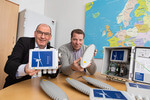07/25/2009
Denmark - Stability of hawk wings used for wind turbine design
Danish scientists are developing a new wind turbine blade that mimics the stability found in hawk wings during highly-turbulent wind events.
The tremendous dynamic loads put on large wind turbine blades shortens the life of fiberglass blades, adding to the total cost of large-scale wind energy development. But researchers at the Risø National Laboratory for Sustainable Energy in Denmark are developing an elastic component for the trailing-edge of large wind turbine blades that could drastically lengthen the life of those blades, thereby reducing the frequency and likelihood of breakage — and ultimately reducing cost.
The goal of the The ADAPWING project is basically to achieve the same degree of wing—or, in this case turbine blade—regulation as found in hawks. Even in the most challenging and turbulent winds, hawks are able to keep their head and eyes fixed using a combination of active and passive regulation of wings.
The technique is also similar to that used on aircraft, where flaps regulate the lift and stabilize the load during the most critical times such as at take-off and landing. But the difference between the technology used in aeronautics and the one being developed for the wind turbines, is that the turbine blades would be constructed with an elastic material, allowing the shape of the blade to change on its own. Whereas, on an airplane the wings are built with a hinged flap that is normally controlled manually from the cockpit.
Research specialist on the project, Helge Aagaard Madsen, explains: “Providing the blade with a movable trailing edge it is possible to control the load on the blade and extend the life time of the wind turbine components.”
Researchers hope to soon begin testing of the ADAPWING technology in wind tunnels where they can control loads and monitor performance.
“If the results confirm our estimated performance,” said Madsen, “we will test the rubber trailing edge on a full-scale wind turbine within a few years.”
For more information please contact Trevor Sievert at ts@windfair.net
The tremendous dynamic loads put on large wind turbine blades shortens the life of fiberglass blades, adding to the total cost of large-scale wind energy development. But researchers at the Risø National Laboratory for Sustainable Energy in Denmark are developing an elastic component for the trailing-edge of large wind turbine blades that could drastically lengthen the life of those blades, thereby reducing the frequency and likelihood of breakage — and ultimately reducing cost.
The goal of the The ADAPWING project is basically to achieve the same degree of wing—or, in this case turbine blade—regulation as found in hawks. Even in the most challenging and turbulent winds, hawks are able to keep their head and eyes fixed using a combination of active and passive regulation of wings.
The technique is also similar to that used on aircraft, where flaps regulate the lift and stabilize the load during the most critical times such as at take-off and landing. But the difference between the technology used in aeronautics and the one being developed for the wind turbines, is that the turbine blades would be constructed with an elastic material, allowing the shape of the blade to change on its own. Whereas, on an airplane the wings are built with a hinged flap that is normally controlled manually from the cockpit.
Research specialist on the project, Helge Aagaard Madsen, explains: “Providing the blade with a movable trailing edge it is possible to control the load on the blade and extend the life time of the wind turbine components.”
Researchers hope to soon begin testing of the ADAPWING technology in wind tunnels where they can control loads and monitor performance.
“If the results confirm our estimated performance,” said Madsen, “we will test the rubber trailing edge on a full-scale wind turbine within a few years.”
For more information please contact Trevor Sievert at ts@windfair.net
- Source:
- Risø National Laboratory for Sustainable Energy
- Author:
- Posted by: Trevor Sievert, Online Editorial Journalist
- Email:
- ts@windfair.net
- Link:
- www.windfair.net/...
- Keywords:
- Risø National Laboratory for Sustainable Energy, wind energy, renewable energy, wind turbine, wind power, wind farm, rotorblade, onshore, offshore
























